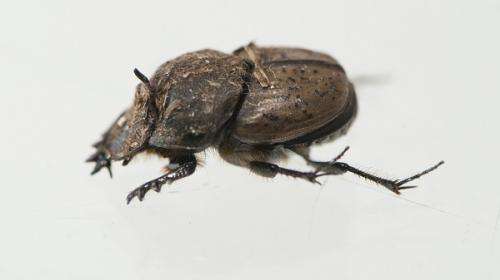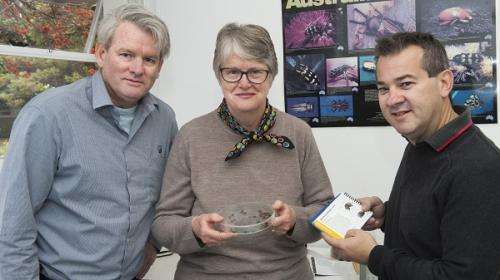A new species of dung beetle will be released in the Great Southern this week to tackle bush fly numbers. Credit: DAFWA
A two-year survey of dung beetle populations in Australia's south-west has pinpointed Kojonup as the WA release site most likely to establish a new population of French dung beetles.
Based on the Department of Agriculture and Food WA (DAFWA) survey, CSIRO have released several hundred Onthophagus vacca beetles onto a cattle farm in the Kojonup area.
The release is part of an effort to reduce the impact of bushflies on WA tourism by using dung beetles to bury the dung in which flies breed.
WA is already home to around ten species of dung beetle, introduced by CSIRO between 1969 and 1984 to combat bushfly numbers.
"We didn't want to bring our new beetles in and release them in an area that's overrun with other beetles," says Rob Emery, senior entomologist with DAFWA and survey lead.
"We wanted to ensure their best chance."
Mr Emery's team hand-collected around 1200 dung pats to bait beetle traps across a dozen sites.
"We wanted to understand what the existing species are doing and how things had changed in the last 30 years," Mr Emery says.
"We looked for places where we had farmers with cattle.
We wanted to go across a range of climatic areas, pretty much in a line, from Badgingarra down almost to Albany."
Department of Agriculture and Food (DAFWA) entomologist Rob Emery, CSIRO researcher Jane Wright and DAFWA technical officer David Cousins with a spring-active beetle Onthophagus vacca, which will be released this week at sites around Kojonup. Credit: DAFWA
The beetle traps are basically buckets, buried in the ground with a muslin-wrapped dung pat as bait.
"Dung beetles in the area will be attracted to that smelly pile of dung, they'll climb around on it, then they'll just drop into the bucket below."
Beetles collected this way were surveyed on the spot or taken to the lab for identification and sexing, the difficulty of which depends on the species.
"With O. vacca, the males are completely different, they have a really long horn," Mr Emery says.
"The females have two smaller horns on either side. Sexing them is pretty easy."
He says a previous attempt to introduce O. vacca to Australia failed, probably because of incompatible climate.
This time, the team combined their population survey results with climate-matching software to shortlist suitable areas for release.
The O. vacca species was chosen because it's spring-active, filling a seasonal gap for WA.
"We have good coverage for summer, winter and autumn, but no beetles are active in the springtime."
Mr Emery says it will be ten or twenty years before its known if the beetles are a success.
Provided by Science Network WA























